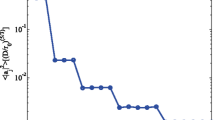Abstract
This paper presents B-MFBD, a parallel hybrid of bispectrum speckle imaging (SI) and multi-frame blind deconvolution (MFBD) image reconstruction techniques for anisoplanatic, long horizontal path imaging. Our aim is to recover an enhanced version of a turbulence-corrupted image by massive parallelization of an SI and MFBD algorithms. The bispectrum SI technique is used in place of the multi-frame ensemble averaging to initialize the iterative parallel MFBD algorithm. B-MFBD technique, through massive parallelization, provides significantly large improvement in execution speed to both the bispectrum SI and MFBD parts of the hybrid algorithm. We report \(85\,\%\) improvement in processing time with respect to the sequential implementation of the same algorithm for a \(256 \times 256\), gray-scale image, with comparable improvement in image quality.



Similar content being viewed by others
Notes
A is binary aperture function which is 1 in the aperture and 0 outside the aperture.
References
Archer, G.E., Bos, J.P., Roggemann, M.C.: Mean squared error performance of MFBD nonlinear scene reconstruction using speckle imaging in horizontal imaging applications. In: Proc. SPIE, Visual information processing XXI, vol. 8399. Baltimore (2012)
Archer, G.E., Bos, J.P., Roggemann, M.C.: Reconstruction of long horizontal-path images under anisoplanatic conditions using multiframe blind deconvolution. Opt. Eng. 52(8), 083,108–083,108 (2013)
Archer, G.E., Bos, J.P., Roggemann, M.C.: Comparison of bispectrum, multiframe blind deconvolution and hybrid bispectrum-multiframe blind deconvolution image reconstruction techniques for anisoplanatic, long horizontal-path imaging. Opt. Eng. 53(4), 043,109-1-15 (2014)
Ayers, G.R., Dainty, J.C.: Iterative blind deconvolution method and its applications. Opt. Lett. 13(7), 547–549 (1988)
Ayers, G.R., Northcott, M.J., Dainty, J.C.: Knox-thompson and triple-correlation imaging through atmospheric turbulence. J. Opt. Soc. Am. 5(7), 963–985 (1988)
Bartelt, H., Lohmann, A.W., Wirnitzer, B.: Phase and amplitude recovery from bispectra. Appl. Opt. 23(18), 3121–3129 (1984)
Bell, N., Garland, M.: Efficient sparse matrix-vector multiplication on CUDA. Tech. rep., NVIDIA technical report NVR-2008-004 (2008)
Bos, J.P., Archer, G.E., Roggemann, M.C.: Using speckle imaging techniques as a starting point for MFBD scene reconstruction from long horizontal-path, turbulence-degraded imagery. In: Proc. SPIE: laser communication and propagation through the atmosphere and oceans II, vol. 8874. San Diego (2013)
Bos, J.P., Paolini, A., Kelmelis, E.J., Roggemann, M.C.: Mean square error performance evaluation of a commercial speckle imaging system using simulated imagery. In: Proc. SPIE 9095, modeling and simulation for defense systems and applications IX, vol. 9095. Baltimore (2014)
Bos, J.P., Roggemann, M.C.: Robustness of speckle imaging techniques applied to horizontal imaging scenarios. Opt. Eng. 51(8), 083,201-1–083,201-18 (2012)
Bos, J.P., Roggemann, M.C.: Technique for simulating anisoplanatic image formation over long horizontal paths. Opt. Eng. 51(10), 101,704 (2012)
Fraser, D., Thorpe, G., Lambert, A.: Atmospheric turbulence visualization with wide-area motion-blur restoration. J. Opt. Soc. Am. 16(7), 1751–1758 (1999)
Hajmohammadi, S., Nooshabadi, S., Bos, J.P.: Massive parallel processing of image reconstruction from bispectrum through turbulence. Appl. Opt. 54(32), 9370–9378 (2015)
Hirsch, M., Harmeling, S., Sra, S., Schölkopf, B.: Online multi-frame blind deconvolution with super-resolution and saturation correction. Astron. Astrophys. 531(A9) (2011)
Law, N., Lane, R.: Blind deconvolution using least squares minimisation. Opt. Commun. 128(4–6), 341–352 (1996)
Linderman, R., Spetka, S., Emeny, S., Fitzgerald, D.: Parallelizing a multi-frame blind deconvolution algorithm on clusters of multicore processors. IEEE Aerospace conference pp. 1–7 (2009)
Matson, C.L., Borelli, K., Jefferies, S., Beckner, C.C., Keith, E.: Fast and optimal multiframe blind deconvolution algorithm for high-resolution ground-based imaging of space objects. Appl. Opt. 48(1), A75–A92 (2009). doi:10.1364/AO.48.000A75
Nocedal, J., Wright, S.: Numerical optimization. Springer Series in Operations Research and Financial Engineering, 2nd edn. Springer, New York (2006)
Ohtsubo, J., Nakajima, K.: Image recovery by simulated annealing with known fourier modulus. Opt. Commun. 128(3–4), 265–270 (1991)
Parhi, K.K.: VLSI digital signal processing systems: design and implementation. Wiley, New Jersey (1999)
Petersen, F. C., Paolini, A.: ATCOM: accelerated image processing for terrestrial long-range imaging through atmospheric effects. In: Proceeding of SPIE 8713, defense, security, and sensing: Airborne Intelligence, Surveillance, Reconnaissance (ISR) Systems and Applications X, Baltimore (2013)
Petropulu, A.P., Pozidis, H.: Phase reconstruction from bispectrum slices. IEEE Trans. Signal Process. 46(2), 527–530 (1998). doi:10.1109/78.655441
Roggemann, M.C., Welsh, B.M.: Imaging through turbulence. CRC Press, Boca Raton (1996)
Rojas, F., Solé-Casals, J., Puntonet, C.: An evolutionary approach for blind inversion of wiener systems. In: Davies, M., James, C., Abdallah, S., Plumbley, M. (eds.) Independent component analysis and signal separation. Lecture notes in computer science, vol. 4666, pp. 260–267. Springer, Berlin (2007)
Turner, N.H., ten Brummelaar, T.A., McAlister, H.A., Mason, B.D., Hartkopf, W.I., Roberts Jr., L.C.: Attainment of diffraction limited resolution in large telescopes by fourier analysing speckle patterns in star images. Astron. J. 6, 85–87 (1970)
Tyler, D.W., Schulze, K.J.: Fast phase spectrum estimation using the parallel part-bispectrum algorithm. Publ. Astron. Soc. Pac. 116, 65–76 (2004). doi:10.1086/380765
Vorontsov, M.A., Carhart, G.W.: Anisoplanatic imaging through turbulent media: image recovery by local information fusion from a set of short-exposure images. J. Opt. Soc. Am. 18(6), 1312–1324 (2001)
Wang, N., Chen, Y., Nakao, Z., Tamura, S.: Parallel-distributed blind deconvolution based on a self-organizing neural network. Appl. Opt. 38(20), 4345–4353 (1999)
Xu, L., Ren, J.S., Liu, C., Jia, J.: Deep convolutional neural network for image deconvolution. In: Annual conference on neural information processing systems (NIPS). Montreal, Canada (2014)
Author information
Authors and Affiliations
Corresponding author
Rights and permissions
About this article
Cite this article
Hajmohammadi, S., Nooshabadi, S., Archer, G.E. et al. Parallel hybrid bispectrum-multi-frame blind deconvolution image reconstruction technique. J Real-Time Image Proc 16, 919–929 (2019). https://doi.org/10.1007/s11554-016-0577-z
Received:
Accepted:
Published:
Issue Date:
DOI: https://doi.org/10.1007/s11554-016-0577-z




